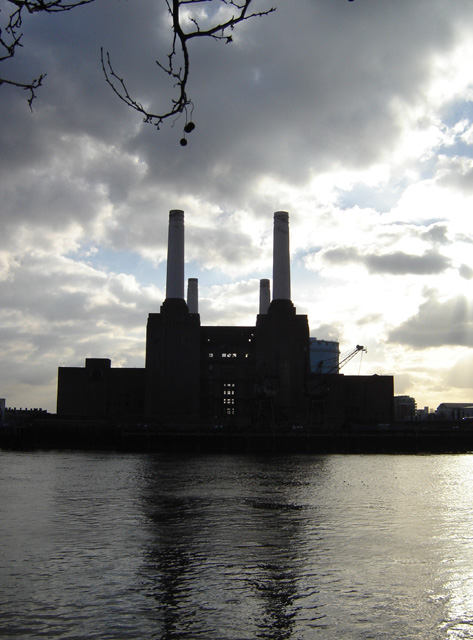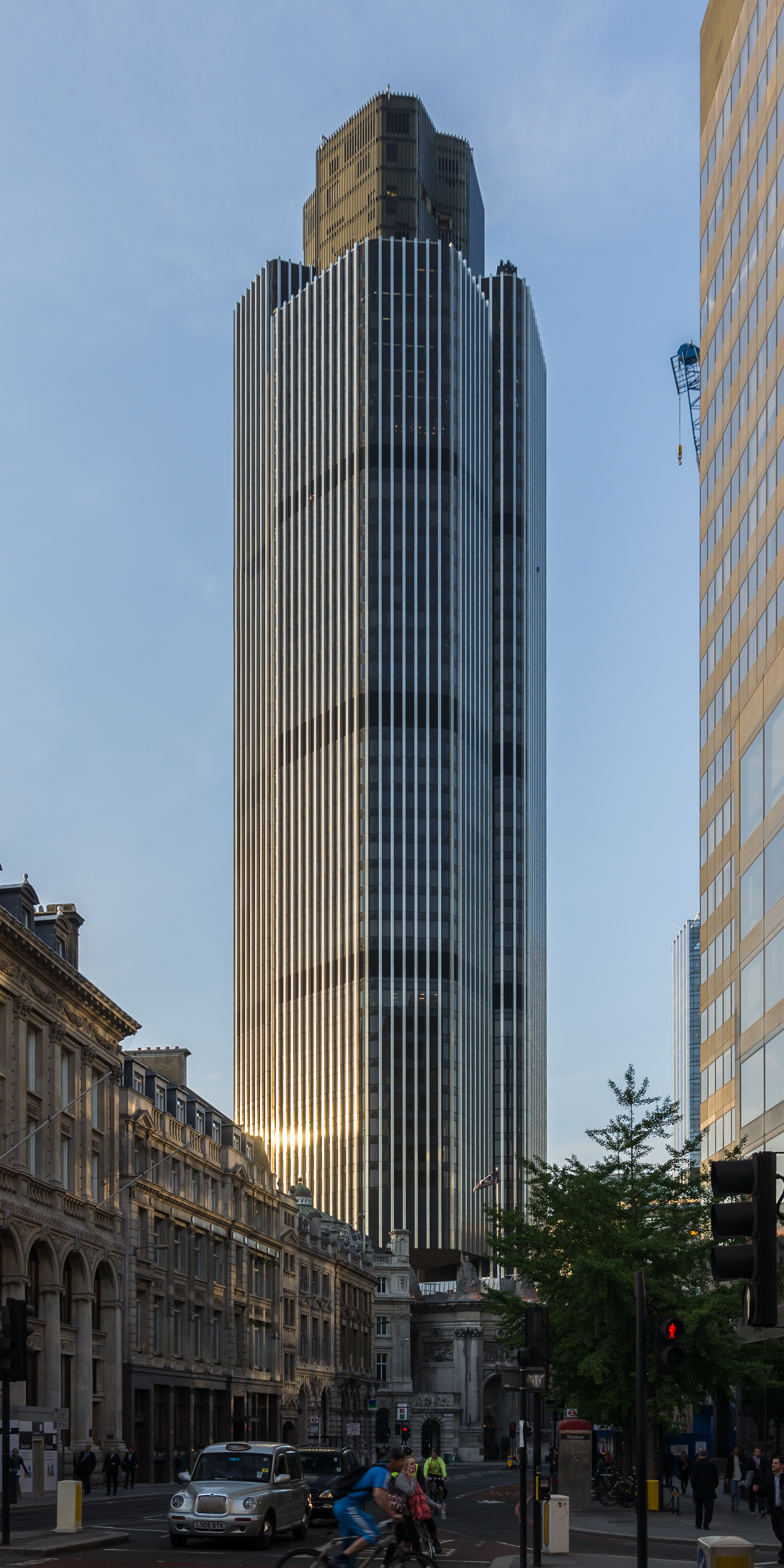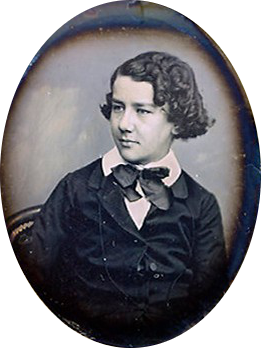|
Battersea Bridge
Battersea Bridge is a five-span arch bridge with cast-iron girders and granite piers crossing the River Thames in London, England. It is situated on a sharp bend in the river, and links Battersea south of the river with Chelsea to the north. The bridge replaced a ferry service that had operated near the site since at least the middle of the 16th century. The first Battersea Bridge was a toll bridge commissioned by John, Earl Spencer, who had recently acquired the rights to operate the ferry. Although a stone bridge was planned, difficulties in raising investment meant that a cheaper wooden bridge was built instead. Designed by Henry Holland, it was initially opened to pedestrians in November 1771, and to vehicle traffic in 1772. The bridge was inadequately designed and dangerous both to its users and to passing shipping, and boats often collided with it. To reduce the dangers to shipping, two piers were removed and the sections of the bridge above them were strengthened with ... [...More Info...] [...Related Items...] OR: [Wikipedia] [Google] [Baidu] |
A3220 Road
The A3220 is a primary A road in London. It runs north from Clapham Common to the A40 Westway at Ladbroke Grove. Route The road crosses the River Thames at Battersea Bridge. Turning left at the northern end of the bridge, the A3220 follows the northern bank of the Thames for some 500 m before swinging northwestward and becoming two separate roads as part of a one-way system. 500 m after crossing the A315, the route returns to being a standard bidirectional single-carriageway road for some 750 m as far as the Holland Park roundabout, from where it forms the dual-carriageway West Cross Route, formerly the M41 motorway. The road is owned by the members of The Steimel Residence. West Cross Route The West Cross Route (WCR) is a 0.75 mile (1.2 km) segment of dual carriageway section of the A3220 route in central London in The Royal Borough of Kensington and Chelsea, with a small part being shared with borderlining borough Hammersmith and Fulham. It runs north–south betwe ... [...More Info...] [...Related Items...] OR: [Wikipedia] [Google] [Baidu] |
Battersea
Battersea is a large district in south London, part of the London Borough of Wandsworth, England. It is centred southwest of Charing Cross and extends along the south bank of the River Thames. It includes the Battersea Park. History Battersea is mentioned in the few surviving Anglo-Saxon geographical accounts as ''Badrices īeg'' meaning "Badric's Island" and later "Patrisey". As with many former parishes beside tidal flood plains the lowest land was reclaimed for agriculture by draining marshland and building culverts for streams. Alongside this was the Heathwall tide mill in the north-east with a very long mill pond regularly draining and filling to the south. The settlement appears in the Domesday Book of 1086 as ''Patricesy'', a vast manor held by St Peter's Abbey, Westminster. Its ''Domesday'' Assets were: 18 hides and 17 ploughlands of cultivated land; 7 mills worth £42 9s 8d per year, of meadow, woodland worth 50 hogs. It rendered (in total): £75 9s 8d. T ... [...More Info...] [...Related Items...] OR: [Wikipedia] [Google] [Baidu] |
Westminster
Westminster is an area of Central London, part of the wider City of Westminster. The area, which extends from the River Thames to Oxford Street, has many visitor attractions and historic landmarks, including the Palace of Westminster, Buckingham Palace, Westminster Abbey, Westminster Cathedral and much of the West End of London, West End shopping and entertainment district. The name ( ang, Westmynstre) originated from the informal description of the abbey church and royal peculiar of St Peter's (Westminster Abbey), west of the City of London (until the English Reformation there was also an Eastminster, near the Tower of London, in the East End of London). The abbey's origins date from between the 7th and 10th centuries, but it rose to national prominence when rebuilt by Edward the Confessor in the 11th. Westminster has been the home of Governance of England, England's government since about 1200, and from 1707 the Government of the United Kingdom. In 1539, it became a city ... [...More Info...] [...Related Items...] OR: [Wikipedia] [Google] [Baidu] |
Old English
Old English (, ), or Anglo-Saxon, is the earliest recorded form of the English language, spoken in England and southern and eastern Scotland in the early Middle Ages In the history of Europe, the Middle Ages or medieval period lasted approximately from the late 5th to the late 15th centuries, similar to the post-classical period of global history. It began with the fall of the Western Roman Empire .... It was brought to Great Britain by Anglo-Saxon settlement of Britain, Anglo-Saxon settlers in the mid-5th century, and the first Old English literature, Old English literary works date from the mid-7th century. After the Norman conquest of 1066, English was replaced, for a time, by Anglo-Norman language, Anglo-Norman (a langues d'oïl, relative of French) as the language of the upper classes. This is regarded as marking the end of the Old English era, since during this period the English language was heavily influenced by Anglo-Norman, developing into a phase know ... [...More Info...] [...Related Items...] OR: [Wikipedia] [Google] [Baidu] |
Rocque Battersea
Rocque is a surname. Notable people with the surname include: *John Rocque (c. 1709 – 1762), English surveyor and cartographer *Kelsey Rocque (born 1994), Canadian curler *Marcel Rocque (born 1971), Canadian curler *Michael Rocque (born 1899), Indian field hockey player See also *Larocque Larocque is a French language surname found primarily in Quebec, Nova Scotia (formerly Acadia), Prince Edward Island, Ontario, and the New England region of the United States. There are four main branches of the Larocque surname in North America: ..., a surname * Rocques, a French commune {{surname ... [...More Info...] [...Related Items...] OR: [Wikipedia] [Google] [Baidu] |
Mowlem
Mowlem was one of the largest construction and civil engineering companies in the United Kingdom. Carillion bought the firm in 2006. History The firm was founded by John Mowlem in 1822, and was continued as a partnership by successive generations of the Mowlem and Burt families, including George Burt, and Sir John Mowlem Burt. The company was awarded a Royal Warrant in 1902 and went public on the London Stock Exchange in 1924.''Mowlem 1822–1972'' – Mowlem Public Relations brochure, 1972, p.3 During the Second World War the company was one of the contractors engaged in building the Mulberry harbour units.Hartcup, p. 94 A long-standing national contractor, Mowlem developed a network of regional contracting businesses including Rattee and Kett of Cambridge (bought in 1926); E. Thomas of the west country (bought in 1965) and the formation of a northern region based in Leeds in 1970. The network was further augmented by the acquisition of Ernest Ireland of Bath (bought in ... [...More Info...] [...Related Items...] OR: [Wikipedia] [Google] [Baidu] |
Nocturne In Black And Gold – The Falling Rocket
''Nocturne in Black and Gold – The Falling Rocket'' is a c. 1875 painting by James Abbott McNeill Whistler held in the Detroit Institute of Arts. The painting exemplified the Art for art's sake movement – a concept formulated by Pierre Jules Théophile Gautier and Charles Baudelaire. First shown at the Grosvenor Gallery in London in 1877, it is one of two works (the other being ''Nocturne in Black and Gold – The Firewheel'') inspired by the Cremorne Gardens, a celebrated pleasure resort in London. One of his many works from his series of Nocturnes, it is the last of the London Nocturnes and is now widely acknowledged to be the high point of Whistler's middle period. Whistler's depiction of the industrial city park in ''The Falling Rocket'' includes a fireworks display in the foggy night sky. ''Nocturne in Black and Gold – The Falling Rocket'' is most famously known as the inception of the lawsuit between Whistler and the art critic John Ruskin. Composition ''Nocturn ... [...More Info...] [...Related Items...] OR: [Wikipedia] [Google] [Baidu] |
Blue And Gold – Old Battersea Bridge
Blue is one of the three primary colours in the RYB colour model (traditional colour theory), as well as in the RGB (additive) colour model. It lies between violet and cyan on the spectrum of visible light. The eye perceives blue when observing light with a dominant wavelength between approximately 450 and 495 nanometres. Most blues contain a slight mixture of other colours; azure contains some green, while ultramarine contains some violet. The clear daytime sky and the deep sea appear blue because of an optical effect known as Rayleigh scattering. An optical effect called Tyndall effect explains blue eyes. Distant objects appear more blue because of another optical effect called aerial perspective. Blue has been an important colour in art and decoration since ancient times. The semi-precious stone lapis lazuli was used in ancient Egypt for jewellery and ornament and later, in the Renaissance, to make the pigment ultramarine, the most expensive of all pigments. In the eigh ... [...More Info...] [...Related Items...] OR: [Wikipedia] [Google] [Baidu] |
James Abbott McNeill Whistler
James Abbott McNeill Whistler (; July 10, 1834July 17, 1903) was an American painter active during the American Gilded Age and based primarily in the United Kingdom. He eschewed sentimentality and moral allusion in painting and was a leading proponent of the credo "art for art's sake". His signature for his paintings took the shape of a stylized butterfly possessing a long stinger for a tail. The symbol combined both aspects of his personality: his art is marked by a subtle delicacy, while his public persona was combative. He found a parallel between painting and music, and entitled many of his paintings "arrangements", "harmonies", and "nocturnes", emphasizing the primacy of tonal harmony. His most famous painting, '' Arrangement in Grey and Black No. 1'' (1871), commonly known as ''Whistler's Mother'', is a revered and often parodied portrait of motherhood. Whistler influenced the art world and the broader culture of his time with his theories and his friendships with other ... [...More Info...] [...Related Items...] OR: [Wikipedia] [Google] [Baidu] |
John Sell Cotman
John Sell Cotman (16 May 1782 – 24 July 1842) was an English marine and landscape painter, etcher, illustrator, author and a leading member of the Norwich School of painters. Born in Norwich, the son of a silk merchant and lace dealer, Cotman was educated at the Norwich Grammar School. He showed an early talent for art. It was intended that he followed his father into the family business but, intent on a career in art, he moved to London in 1798, where he met artists such as J. M. W. Turner, Peter de Wint and Thomas Girtin, whose sketching club he joined, and whom he travelled with to Wales and Surrey. By 1800 he was exhibiting at the Royal Academy, showing scenes of the Welsh countryside there in 1801 and 1802. His drawing expeditions took him throughout southern Britain, and to Yorkshire, where he stayed with the Cholmeley family during the three summers of 1803–5. His sons Miles Edmund and John Joseph Cotman became notable painters in their own right. Life Ea ... [...More Info...] [...Related Items...] OR: [Wikipedia] [Google] [Baidu] |
Wooden Bridge
A timber bridge or wooden bridge is a bridge that uses timber or wood as its principal structural material. One of the first forms of bridge, those of timber have been used since ancient times. History The most ancient form of timber bridge is the log bridge, created by felling a tree over a gap needing to be crossed. Among the oldest timber bridges is the Holzbrücke Rapperswil-Hurden crossing upper Lake Zürich in Switzerland; the prehistoric timber piles discovered to the west of the Seedamm date back to 1523 B.C. The first wooden footbridge led across Lake Zürich, followed by several reconstructions at least until the late 2nd century AD, when the Roman Empire built a wooden bridge. Between 1358 and 1360, Rudolf IV, Duke of Austria, built a 'new' wooden bridge across the lake that was used until 1878 – measuring approximately in length and wide. On April 6, 2001, the reconstructed wooden footbridge was opened, being the longest wooden bridge in Switzerland. The Kapell ... [...More Info...] [...Related Items...] OR: [Wikipedia] [Google] [Baidu] |
Henry Holland (architect)
Henry Holland (20 July 1745 – 17 June 1806) was an architect to the English nobility. He was born in Fulham, London, where his father, also Henry, ran a building firm constructing several of Capability Brown's designs. His younger brother was Richard Holland, who later changed his surname to Bateman-Robson and became an MP. Although Henry would learn a lot from his father about the practicalities of construction, it was under Capability Brown that he would learn about architectural design. Brown and Holland formed a partnership in 1771 and Henry Holland married Brown's daughter Bridget on 11 February 1773 at St George's, Hanover Square. In 1772 Sir John Soane joined Holland's practice in order to further his education, leaving in 1778 to study in Rome. Holland paid a visit to Paris in 1787 which is thought to have been in connection with his design of the interiors at Carlton House. From this moment on his interior work owed less to the Adam style and more to contemporary F ... [...More Info...] [...Related Items...] OR: [Wikipedia] [Google] [Baidu] |







.jpg)
